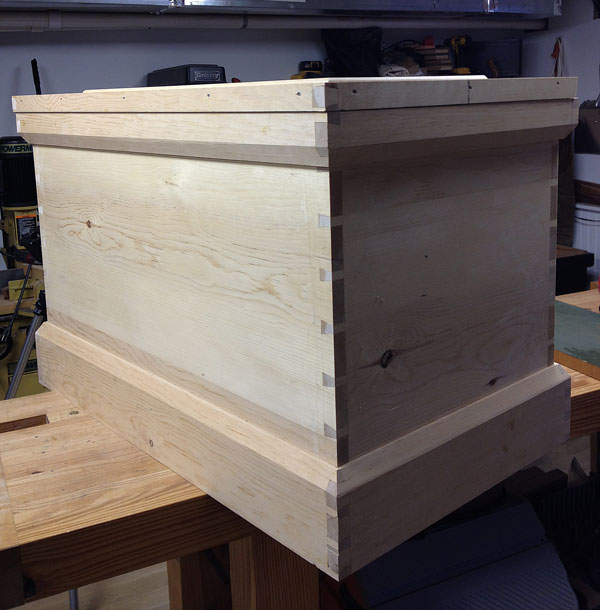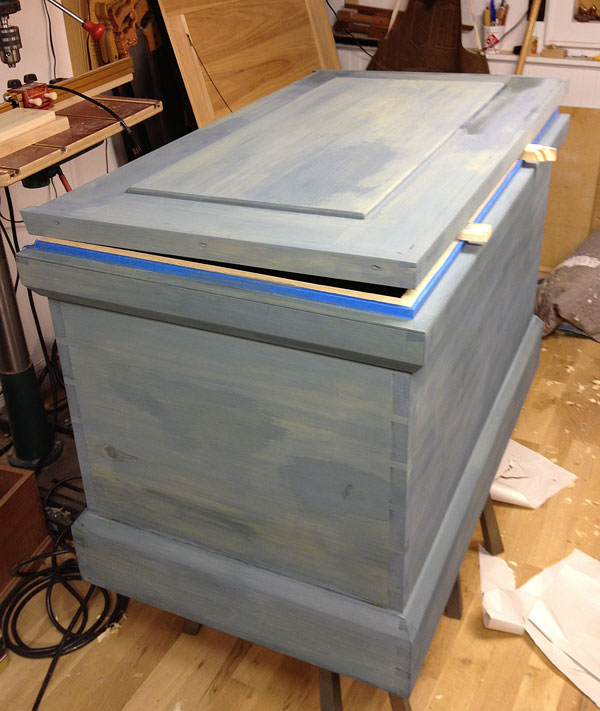We may receive a commission when you use our affiliate links. However, this does not impact our recommendations.
Imagine, if you will, spending somewhere in the neighborhood of 45-50 hours working on a project that not only looks halfway decent, but is destined (or at least intended) to transform your messy and cluttered existence into a neatly organized and tidy way of shop life (see above*).
Then, imagine wetting your brush with your carefully chosen and lovingly mixed milk paint (the color about which you dithered for weeks), then drawing the brush across your freshly planed and sanded surfaces only to think, “Wow – that looks hideous” (see below). (It’s possible that “Wow” is not the interjection of which you would have thought.)
If, however, you’ve read Mike Dunbar’s excellent article on milk paint (from our February 2010 issue), you know there’s no cause for panic. As Mike puts it, “When dry, the first coat will look like something that the cat dragged in.” (On that point, we disagree; my cats have never dragged in something that looked quite so dreadful.) After another coat or two, your initial reaction (and the finish) will be transformed.
Why did I elect to use milk paint instead of easy-to-find and easier to use latex? Milk paint, after all, in its simplest-to-use configuration**, comes as a dry powder that must be mixed (sometimes vigorously, depending on the pigments) with water, has to settle for an hour or so, then takes at least two coats to look decent, plus a protective topcoat. And, because it’s water based, you have to either raise the grain and sand before starting or sand after the first coat. You also have to stir the paint often while you’re painting to keep the pigments from settling, and it’s best-used fresh (ideally, the same day it’s mixed, and no more than two days old, says Mike).
I guess I just like it. Milk paint imparts a wholly traditional look, allows the grain to show through, has interesting subtle color variations and a lovely dead-flat, chalky-looking finish. Plus, it dries really quickly, so if your allotted shop time allows (and you’re not skulking around in someone else’s shop whilst trying to finish – thank you Chris Schwarz), you can apply two, and possibly three coats in a day (if you start early and the humidity is low). And cleanup is easy – you can dump any excess paint down the kitchen sink (and if you use a chip brush, as Mike recommends, you can simply toss that in the trash if you’re not inclined to clean a $1.50 brush).
 I’ve applied two coats thus far (the picture at the right shows the second coat on the lid, already drying in spots). While my original plan was to apply just two coats of “peacock” topped with a coat of “French gray” (both from The Real Milk Paint Co.), then call it done, I like the peacock so much that I’ve ordered more (always allow enough product for a change in plans – oops), and will apply a third coat of it. That may be it for paint. But I’ve a sample board going, too, so I’ll mix up a small amount of the gray and apply it atop the peacock, then rub it away in a few spots to see if I like the faux-aged look and the color combination better than plain peacock.
I’ve applied two coats thus far (the picture at the right shows the second coat on the lid, already drying in spots). While my original plan was to apply just two coats of “peacock” topped with a coat of “French gray” (both from The Real Milk Paint Co.), then call it done, I like the peacock so much that I’ve ordered more (always allow enough product for a change in plans – oops), and will apply a third coat of it. That may be it for paint. But I’ve a sample board going, too, so I’ll mix up a small amount of the gray and apply it atop the peacock, then rub it away in a few spots to see if I like the faux-aged look and the color combination better than plain peacock.
I might also dress it up a bit with some stencil work, to mimic vintage painted chests I’ve seen in museums.
Then there’s a topcoat to consider – but I’ll write about that when I get to it. I’ve a clear, water-based acrylic on order that I’m going to test out on my sample board. (I already tried a coat of linseed oil…the yellowish oil and greenish paint together produced puce. Blech.)
My “Anarchist’s Tool Chest” is almost complete…on the outside. Once the painting is done, I’ll bring it home to finish the interior fittings and tills. (My shop, for those of you who don’t know, is also my study, which has a nice hardwood floor that needs to stay nice – so thanks again to Chris for letting me spatter his shop with casein-based product). And I’m very much looking forward to filling the chest with my planes, chisels, saws etc., rather than moving those tools around on my bench and bookshelves and desktop.
— Megan Fitzpatrick
@1snugthejoiner
* Note: The lead photo was taken before I fit the lid or planed off the tool marks. I don’t know why I didn’t think to take a snap of the prepped-and-ready-to-paint chest…but it possibly had something to do with bourbon.
** You can also make your own milk paint, if you’re so inclined. I am not.
Finishing Resources:
– If you’re new to milk paint and want to give it a try, I urge you to read Mike Dunbar’s article – it’s very good.
– And of course, we have available Bob Flexner’s book “Flexner on Finishing” – 12 years of Bob’s magazine columns updated with new information and images, and collected in a gorgeously designed hardcover book (which, curiously, is on sale right now for $15.59…less than the PDF version)
Here are some supplies and tools we find essential in our everyday work around the shop. We may receive a commission from sales referred by our links; however, we have carefully selected these products for their usefulness and quality.









What did you decide to topcoat with? Brand and sheen?
Great work, Thank you Megan.
Chris Mobley
http://www.cmobleydesigns.com
Yes, Megan, I thought it looked pretty good with only one coat, and I don’t even drink anymore (my choice). But the thought of reveling in the aura of a superior paint job while enjoying a quality bourbon poured over ice sounds really interesting. I may need to give it a try, after shutting down all tools, of course.
I was and idiot and painted my chest with latex based on another idiots recommendation…I think I read it in a book or something. Milk paint is much easier to use, don’t mix it too thin! I too have used shellac over milk paint and love it. Also Curtis Buchanan has an excellent series of videos on making a comb back chair in which he explains how to mix and apply milk paint. I believe the paint mixing happens on video 46. http://www.curtisbuchananchairmaker.com/videos.html
Imagine, if you will, spending somewhere in the neighborhood of 200-300 hours working on a large built-in breakfront project with inset glass-front doors, beaded faceframes, and dovetailed drawers, that not only looks halfway decent, but sensational, and is destined to satisfy a client, bolster your reputation, and to help earn you enough money to shelter and feed yourself.
Then, imagine wetting your brush with your carefully chosen and carefully mixed milk paint–for you are mixing two or three milk-paint colors to achieve a certain color you have chosen after a few days of consideration, because you don’t have time to dither–then drawing the brush across your freshly planed surfaces only to think, “Wow, that looks pretty wack.”
I took the sackback class @ the Windsor Institute and wanted to get the authentic look of a Windsor. So glad Mike gives out info on Milk Paint with the class and what to expect… that first coat looked like a goat’s hairball. Rough. As others have added, additional coats make a HUGE difference. Just stay with it. I believe he recommended danish oil but I don’t have his instructions at hand.
Great chest and storytelling. Thank you for putting such marvelous colour in all your writings 🙂
Do you have an opinion on top coating milk with Danish Oil? I have used it twice and have been happy how it darkens the milk paint without adding color like BLO might. I realize it doesn’t offer the best protection but it sure gives a wonderful feel and texture to the finish.
Yep, I was glad I had read Dunbar’s article first. I wish I had experimented on a test piece though, because my first batch of milk paint was way too thick… sort of like spreading watery peanut butter. After I got that sorted out, then it worked better. But I had to buy a second bag of the powder for additional coat(s). I’ll have to try David’s suggestion of letting it sit overnight.
“And, because it’s water based, you have to either raise the grand and sand before starting or sand after the first coat.”
Ha! – Obviously a typo that escaped Word’s spell check, but the substitution of “grand” for “grain” is amusingly ironic. I estimated the last chest I built was worth about a grand based on time and materials.
By the way, if you allow milk paint from The Real Milk Paint Company to solubilize overnight before applying it, the paint is considerably smoother and less lumpy. There’s no negative affect on adhesion as far as I can tell.
Personally, I don’t top-coat milk paint very often. I prefer the “chalky” look. But I have tried 2 coats of super-blond shellac over a thoroughly cured milk-paint finish (and I mean THOROUGHLY cured – there’s a lot of water in the paint, which wicks into the wood when applied). Once the shellac is dry, I go over the piece with a medium-fine synthetic steel wool gray pad from Klingspor’s Woodworking Shop, which dulls the occasional shiny spot imparted by the shellac overcoat.
It works well, and shellac adheres to the milk paint undercoat far better than laquer or alkyld varnish.
Nice work, Megan. it looks great.